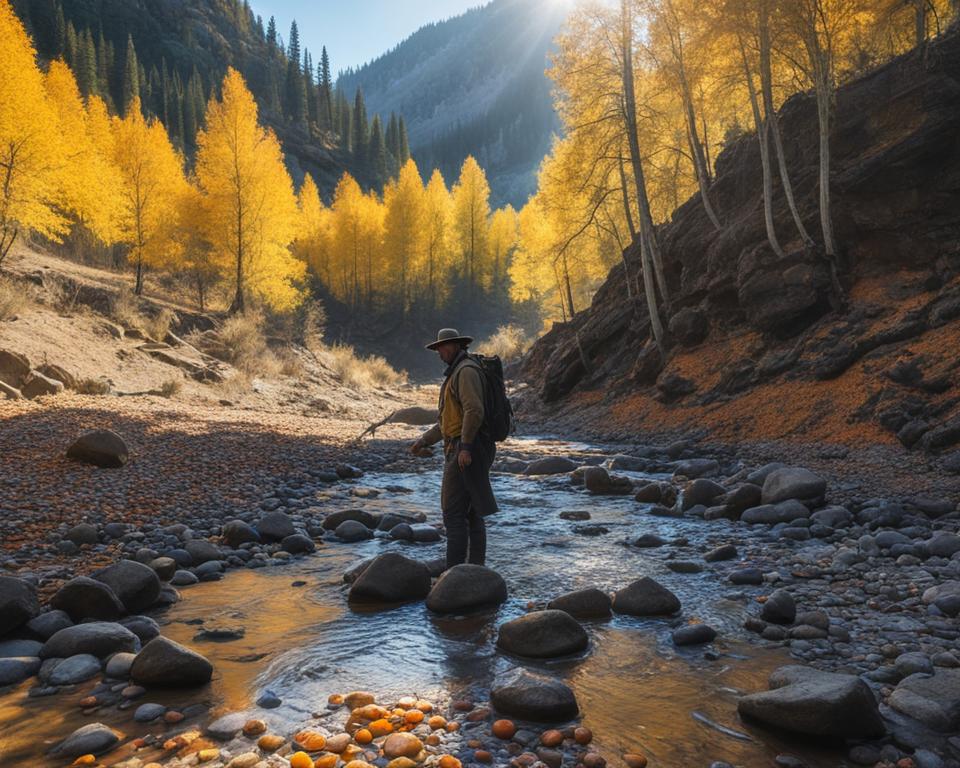
Gold prospecting is a year-round activity that can be influenced by the changing seasons. Understanding how seasons affect gold prospecting methods can help optimize your gold mining efforts throughout the year. In this article, we will explore the tips and techniques for gold prospecting in different seasons and provide insights into the best times to engage in this exciting hobby.
Key Takeaways
- Gold prospecting can be pursued in different seasons, each offering unique challenges and advantages.
- Adapt your prospecting techniques and gear according to the specific conditions of each season.
- Winter offers lower water levels and less competition, making it a great time for gold prospecting.
- Spring brings melting snow and increased water flow, uncovering new gold deposits.
- Summer allows access to previously inaccessible areas, but requires precautions for the heat and water scarcity.
Prospecting in Winter
Winter can pose unique challenges for gold prospecting enthusiasts, but it also presents exciting opportunities for those willing to venture out into the cold. With lower water levels and reduced competition from other prospectors, winter can be an ideal time to search for gold.
However, it’s crucial to be well-prepared and equipped with the right gear to ensure a safe and successful prospecting experience. Cold weather conditions demand special considerations to protect yourself from freezing temperatures and stay comfortable during your winter gold hunting expeditions.
Winter Gold Hunting Tips
When it comes to winter gold prospecting, here are some essential tips to keep in mind:
- Dress appropriately: Layer your clothing to stay warm. Wear thermal base layers, insulating mid-layers, and a waterproof outer shell. Don’t forget a warm hat, gloves, and insulated boots. It’s also advisable to bring spare clothing in case you get wet.
- Stay hydrated: Even in cold weather, dehydration can occur. Always carry enough water and pack a thermos with a hot drink to keep you warm and hydrated throughout your prospecting trip.
- Be cautious with ice: Pay attention to ice conditions when walking near frozen bodies of water. Avoid venturing onto thin ice or areas where the ice may be unstable. Remember to carry ice cleats or traction devices for added safety.
- Use suitable tools: Choose gold prospecting tools that are appropriate for winter conditions. Consider using a gold pan with deeper sidewalls to prevent snow and ice from interfering with your panning process. Additionally, using a scoop or trowel with an extended handle can help you access gravel and crevices without having to remove your gloves frequently.
- Plan your excursions: Before heading out, research the weather conditions and the accessibility of your chosen prospecting areas. Make sure to inform someone of your plans and expected return time. It’s always better to prospect with a partner to enhance safety.
By following these winter gold hunting tips and being well-prepared, you can venture into the cold weather confidently and increase your chances of finding valuable gold deposits.
Cold Weather Prospecting Gear
Investing in the right gear for winter gold prospecting is essential for your comfort, safety, and success. Here are some crucial items to consider:
| Essential Cold Weather Gear | Benefits |
|---|---|
| Insulated Waterproof Boots | Keep your feet warm and dry during your prospecting adventures. |
| Thermal Base Layers | Provide an extra layer of warmth and help regulate body temperature. |
| Insulated Gloves | Protect your hands from the cold and ensure dexterity for handling tools. |
| Warm Hat and Neck Gaiter | Keep your head and neck warm to prevent heat loss. |
| Waterproof Outer Shell | Protect yourself from rain, snow, and wind while prospecting. |
| Hand Warmers | Provide additional warmth in your gloves or pockets. |
| Ice Cleats or Traction Devices | Ensure stability and minimize the risk of slips and falls on icy terrain. |
Having the right gear will not only keep you comfortable but also enable you to focus on the task at hand—finding gold.
With the right knowledge, gear, and precautions, winter gold prospecting can be a rewarding and exhilarating experience. Stay warm, stay safe, and happy prospecting!
Prospecting in Spring
After a long winter, spring brings new opportunities for gold prospecting enthusiasts. The seasonal changes, such as melting snow and increased water flow, can reveal new gold deposits and make it an exciting time to explore. Here are some valuable tips and techniques to make the most of your springtime gold hunting:
- Research and reassess: As the seasons change, so do the dynamics of gold deposits. Take the time to research and understand how the winter weather has affected the local geological conditions. This will help you identify potential new gold-bearing areas that may have been uncovered by ice or snow melt.
- Follow the water: Springtime brings increased water flow, which can wash away lighter materials and expose heavier gold particles. Focus your efforts on areas where water is moving, such as rivers, streams, and creeks. Look for eddies, bends, and natural traps where gold may have settled.
- Target flood plains: The higher water levels and occasional spring floods can deposit gold on the flood plains of rivers and streams. These areas act as natural traps for gold particles, making them prime locations for prospecting. Pay attention to areas where the land flattens out and widens, as gold can get trapped in the slower-moving waters.
- Utilize specialized equipment: Spring gold prospecting may require different tools and equipment compared to other seasons. Consider using a gold pan with larger riffles to handle the increased volume of sediment and gravels that come with the higher water flow. A sluice box can also be effective for capturing fine gold particles in fast-flowing water.
Remember to always obtain the necessary permits and follow local regulations when prospecting in spring. Now is your chance to get out there and uncover the hidden treasures waiting to be discovered.
“Spring is nature’s way of saying, ‘Let’s party!’ – Robin Williams”
Spring Gold Prospecting Tips:
- Be patient: Spring is a time of transition, and gold prospecting in this season requires patience and adaptability. The changing conditions may require you to try different techniques and areas before finding success.
- Observe nature: Take advantage of the blooming flora and emerging wildlife as indicators of favorable gold-bearing areas. Spring is a time of renewal and growth, and the presence of certain plants and animals can signify the presence of gold.
- Network with other prospectors: Connect with experienced prospectors and join local gold prospecting clubs or online communities. Sharing knowledge and experiences can greatly enhance your springtime gold hunting endeavors.
| Spring Gold Prospecting Tips | Description |
|---|---|
| Research and reassess | Stay updated on the changes in geological conditions brought by winter and uncover new gold-bearing areas. |
| Follow the water | Focus your efforts on areas with increased water flow, such as rivers, streams, and creeks, where gold particles can settle. |
| Target flood plains | Search for gold on the flood plains of rivers and streams, as higher water levels and occasional floods can deposit gold in these areas. |
| Utilize specialized equipment | Consider using a gold pan with larger riffles and a sluice box to effectively capture gold particles in fast-flowing water. |
Spring is an exciting time for gold prospecting enthusiasts. With the right strategies and techniques, you can make the most of the seasonal changes and uncover the hidden treasures that await.
Prospecting in Summer
During the summer months, gold prospecting enthusiasts have the opportunity to explore new areas that were previously inaccessible due to higher water levels. The warmer temperatures and longer days create ideal conditions for outdoor activities, including summer gold prospecting.
However, it’s important to be aware of the challenges posed by hot weather and water scarcity. The heat can be intense, and it’s crucial to stay hydrated and protect yourself from sunburn. Additionally, water scarcity in certain regions can limit access to rivers and streams, making it necessary to adjust your prospecting techniques.
If you’re planning to engage in summer gold prospecting, here are some valuable tips to maximize your chances of success:
- Research potential gold-bearing areas: Prioritize areas that are known for their gold deposits and have a history of successful prospecting.
- Focus on dry washing: With water scarcity, dry washing becomes a viable method for extracting gold. This technique involves using a dry washer to separate gold from sand and gravel without the need for water.
- Utilize metal detectors: Metal detectors can be particularly useful during hot weather when water levels are low. They allow you to search for gold nuggets and small deposits in dry creek beds and other areas that are typically submerged during other seasons.
- Stay safe and hydrated: Wear appropriate sun protection, such as a hat and sunscreen, and drink plenty of water to stay hydrated in the summer heat.
Remember, safety should always be a priority. Take precautions to prevent heat-related illnesses and stay aware of your surroundings. If you’re prospecting in remote areas, inform someone of your plans and carry essential supplies, including a first aid kit and plenty of water.
By following these summer gold hunting tips and adapting your techniques to the conditions, you can make the most of your prospecting adventures during the hot summer months. Enjoy the thrill of the hunt and the possibility of uncovering precious gold!
Prospecting in Fall
Fall is a transitional season that offers unique opportunities for fall gold prospecting. As the foliage changes and temperatures become cooler, it creates a picturesque backdrop for your prospecting adventures. The shifting water levels can reveal new gold deposits and modify the dynamics of existing ones. Here are some autumn gold hunting tips and strategies to make the most of your fall gold prospecting before winter arrives.
1. Research Potential Locations
To maximize your fall gold prospecting efforts, it’s important to research potential locations with rich gold deposits. Look for areas where the shifting water levels during the fall season can expose new patches of gold. Geological maps, historical records, and online research can provide valuable insights into productive prospecting sites.
2. Utilize Specialized Equipment
As the weather cools down in the fall, using specialized equipment can improve your chances of finding gold. Consider using a gold pan with larger riffles to capture fine gold particles that might be present in the cooler water. Additionally, a crevice tool can help you extract gold from cracks and crevices that may be more accessible during this season.
3. Follow the Water Flow
During fall, the changing water flow patterns can expose new gold deposits and create ideal conditions for prospecting. Follow the water flow and pay close attention to areas where the water slows down or changes direction. These spots, known as eddy currents, are typically where heavy materials, such as gold, gather. Use your gold pan or sluice box to capture and process the material in these areas.
Pro Tip: The changing water levels and exposed bedrock can also reveal hidden gold veins and pockets that were previously inaccessible.
4. Observe and Learn from Nature
As you explore the fall landscapes, take note of the natural indicators that can guide you to potential gold deposits. Look for rocks with quartz veins, as they are often associated with gold mineralization. Pay attention to the erosion patterns caused by the shifting water flow, as they can expose gold-bearing gravels.
5. Go Beyond Surface Prospecting
While surface prospecting can be productive, don’t hesitate to dig deeper during the fall season. Use your shovel or pickaxe to access deeper layers of gravels where gold may have settled over time. Remember to fill any holes you dig and leave the prospecting site as you found it to preserve the environment.

Embrace the beauty of fall while engaging in this fascinating hobby of fall gold prospecting. The changing colors, cooler temperatures, and shifting water levels offer a unique experience and the chance to uncover hidden treasures. Follow these autumn gold hunting tips and take advantage of the seasonal changes in gold deposits before winter sets in.
Prospecting Gear for All Seasons
When it comes to gold prospecting, having the right gear is essential for success, regardless of the season. Each season brings its own unique challenges and requirements, making it important to have the appropriate equipment and tools to optimize your gold mining efforts. In this section, we will discuss the essential gear for gold prospecting in all seasons and provide insights on how to optimize your equipment for different environments.
Essential Tools for Gold Prospecting
Before delving into the specifics of gear for different seasons, let’s first highlight some essential tools that every gold prospector should have. These tools are fundamental for any prospecting expedition and can be used throughout the year:
- Gold pan: The gold pan is a staple tool for every prospector. It allows you to separate gold from gravel and sediments, making it an essential piece of equipment.
- Classifier: A classifier helps to filter out larger rocks and debris, ensuring that you are left with smaller, more manageable material for panning.
- Snuffer bottle: This handy tool allows you to easily collect fine gold particles, ensuring that you don’t lose any precious flakes during the panning process.
- Magnifying glass: A magnifying glass can be incredibly useful for examining small particles and identifying potential gold specimens.
- Probe and pick: These tools are used for extracting gold nuggets or flakes from crevices and cracks in rocks.
- Bucket and shovel: A sturdy bucket and shovel are essential for collecting material to be processed later.
Now, let’s dive into the specific gear optimized for each season.
Gear for Winter Gold Prospecting
Winter can be a challenging season for gold prospecting due to cold temperatures and potentially icy conditions. However, with the right gear, you can still have a successful and enjoyable experience. Here are some gear recommendations for winter gold prospecting:
| Winter Gold Prospecting Gear |
|---|
| Insulated boots and clothing |
| Thermal gloves and hat |
| Propane heater or hand warmers |
| Waterproof boots and socks |
| Drysuit or wetsuit for water-based prospecting |
| Ice cleats for added traction |
Having the right winter gear will keep you warm and comfortable while allowing you to focus on finding gold.
Gear for Spring Gold Prospecting
Spring is a time of transition and renewed prospecting opportunities. Here are some gear recommendations to optimize your spring gold prospecting:
| Spring Gold Prospecting Gear |
|---|
| Waterproof boots and clothing |
| Light layers for temperature fluctuations |
| Pan and shovel for exploring new areas |
| Hip waders or waterproof boots for stream crossings |
| Metal detector for searching in areas with increased vegetation |
| Compact folding chair or stool for extended periods of prospecting |
With the right gear, you can take advantage of the changing conditions and uncover new gold deposits that emerge during the spring season.
Gear for Summer Gold Prospecting
Summer brings warmer temperatures and increased outdoor activities, making it an ideal time for gold prospecting. However, the heat and potential water scarcity can pose challenges. Here are some gear recommendations to optimize your summer gold prospecting:
| Summer Gold Prospecting Gear |
|---|
| Lightweight clothing with UV protection |
| Brimmed hat for sun protection |
| Hydration pack or water bottles |
| Insect repellent and sunscreen |
| Portable shade canopy or umbrella |
| Handheld fan or cooling towel |
With the appropriate gear, you can stay cool, hydrated, and protected while maximizing your summer gold prospecting efforts.
Gear for Fall Gold Prospecting
Fall is a season of changing colors and shifting water levels. To optimize your fall gold prospecting, consider the following gear recommendations:
| Fall Gold Prospecting Gear |
|---|
| Layered clothing for temperature changes |
| Waterproof boots and rain gear |
| Headlamp or flashlight for shorter daylight hours |
| Rock hammer for breaking through hardened ground |
| Mechanical drywasher for processing larger quantities of material |
| Magnet to attract iron-rich black sands |
By equipping yourself with the right gear, you can make the most of the fall season and its unique gold prospecting opportunities.
Remember, having the right gear is crucial for successful gold prospecting in any season. Whether it’s insulated clothing for winter, waterproof gear for spring, or lightweight attire for summer, investing in the appropriate equipment will greatly enhance your gold mining experiences. Additionally, always consider the specific requirements of each season and ensure your gear is optimized to overcome the challenges and maximize your chances of finding gold.
Best Tips for Seasonal Gold Hunting
Gold hunting is a thrilling adventure that varies with each season. To ensure success in your prospecting efforts, it’s crucial to tailor your techniques to the specific season and optimize your gold mining efforts accordingly. In this section, we’ll share valuable tips and insights for seasonal gold hunting, with a focus on targeting specific seasons and optimizing your chances of finding gold.
1. Research the Season: Before you head out on your gold hunting expedition, take the time to research the specific characteristics and conditions of the season you plan to explore. Understanding the seasonal changes in the gold deposits and the ideal prospecting locations will greatly enhance your success rate.
2. Equip Yourself: Invest in the appropriate gear and equipment for the season you’ll be prospecting in. This may include items such as waders, waterproof boots, or mesh screens for sifting through sediment. Having the right tools will make your hunting experience more comfortable and efficient.
Targetting Specific Seasons
1. Winter: During winter, focus on areas with lower water levels, such as dry riverbeds or exposed gravel bars. The decreased competition and higher concentration of gold in these areas can optimize your chances of finding gold. Be sure to dress warmly and bring equipment suitable for cold weather conditions.
2. Spring: As snow melts and water levels rise, target areas where the flow of water has exposed new gold deposits. Springtime is a great opportunity to explore rivers, streams, and areas near active water sources. Ensure you have appropriate navigation tools and knowledge of potentially hazardous water conditions.
3. Summer: The hot weather and low water levels during summer create unique hunting opportunities. Look for exposed dry washes or areas with minimal water flow. Additionally, focus on shaded areas near water sources to find cooler and more productive spots. Don’t forget to bring plenty of water and protect yourself from the sun.
4. Fall: As the weather cools down, prospecting in forested areas becomes particularly rewarding. Look for exposed bedrock in creeks and rivers, as the shifting water levels can reveal new gold deposits. Carry the necessary tools for navigating wooded areas and be prepared for changing weather conditions.
By targeting these specific seasons and adapting your techniques accordingly, you can significantly improve your chances of finding gold. Remember to always follow local regulations and obtain permission before prospecting in private or protected areas.
“To increase your chances of finding gold, tailor your techniques to the specific season and focus on areas with favorable conditions and higher concentrations of gold.” – Gold Prospecting Expert
Finding Gold Year-Round
While certain seasons may offer more favorable conditions for gold prospecting, it is possible to find gold year-round with the right knowledge and perseverance. By understanding the geological factors that influence gold deposition and employing versatile prospecting techniques, you can continue your gold mining efforts throughout the year. In this section, we will explore the strategies for finding gold in any season and maximizing your gold recovery.
Gold prospecting is not limited to specific seasons, and with the right approach, you can achieve success no matter the time of year. The key is to adapt your techniques and equipment to the current conditions.
Understanding Geological Factors
To effectively prospect for gold year-round, it’s essential to have a solid understanding of the geological factors that influence gold deposition. Gold is often found in association with certain types of rock formations, such as quartz veins or placer deposits. These formations can be present in various environments, including mountains, rivers, and beaches.
“By studying the geological characteristics of the area you plan to prospect, you can identify potential gold-rich locations,” says geologist Dr. Emily Thompson.
Additionally, understanding the impact of water flow and erosion on gold deposition can help you identify areas with higher chances of finding gold. For example, during heavy rainfall or spring melt, water can carry gold particles and concentrate them in certain areas, such as riverbeds or behind boulders. By analyzing these factors, you can target specific locations and increase your chances of success.
Versatile Prospecting Techniques
Year-round gold prospecting requires employing versatile techniques that can be adapted to different seasons and environments. Here are some techniques worth considering:
- Panning: Panning is a simple and effective technique that can be used in any season. It involves swirling water and sediments in a pan to separate heavy materials, including gold. Panning allows you to cover a large area quickly and is particularly useful in rivers and streams.
- Metal Detecting: Metal detectors are valuable tools for locating gold nuggets or buried treasure. They can be used in various terrains and environments, making them suitable for year-round prospecting. Consider investing in a high-quality metal detector and familiarize yourself with its settings and features to maximize your recovery.
- Sluicing: Sluicing involves running water through a series of channels or boxes, allowing gold to settle and be captured in specially designed riffles or mats. This technique is efficient for processing larger volumes of material and can be used in rivers and streams.
- Drywashing: Drywashing is a technique used in arid environments where water is scarce. It involves using a drywasher, which utilizes air and vibration to separate gold from the surrounding material. This technique is highly effective in desert regions or areas with limited water access.
By incorporating these versatile techniques into your prospecting routine, you can adapt to different seasons and environmental conditions, giving you the best chance of finding gold year-round.
To further enhance your gold recovery efforts, it is important to continuously educate yourself on new prospecting methods, equipment advancements, and local regulations. Participating in gold prospecting forums or joining local prospecting clubs can provide valuable insights and opportunities for knowledge sharing.
Maximizing Gold Recovery
Maximizing gold recovery requires not only effective prospecting techniques but also careful gold extraction and processing. Once you have successfully located gold, it is crucial to handle it properly to avoid losing any precious particles. Here are some tips for maximizing your gold recovery:
- Use proper gold recovery equipment, such as gold pans, sluice boxes, or highbankers, to ensure efficient capture and retention of gold particles.
- Avoid using excessive force when handling gold. Gentle and precise handling minimizes the risk of losing fine gold particles.
- Regularly clean and maintain your prospecting equipment. Proper maintenance helps ensure optimal performance and prevents loss of gold due to equipment malfunctions.
- Consider using specialized gold recovery techniques, such as gold shaker tables or centrifugal concentrators, to extract fine gold particles that may be difficult to recover using traditional methods.
Remember, gold prospecting is a continuous learning process, and experimentation with different techniques and equipment can lead to increased success in your gold mining efforts. By staying informed and adapting your approach, you can enjoy the thrill of finding gold all year round.
| Season | Favorable Conditions | Recommended Techniques |
|---|---|---|
| Winter | Cold weather reduces water flow and exposes new areas for prospecting. | Panning in exposed riverbeds, metal detecting in frozen ground. |
| Spring | Melting snow and increased water flow uncover new gold deposits. | Sluicing in rivers, metal detecting in newly exposed areas. |
| Summer | Lower water levels provide access to previously underwater areas. | Drywashing in arid regions, metal detecting in exposed riverbeds. |
| Fall | Changing water levels reveal new gold deposits and alter existing ones. | Panning in rivers, metal detecting in areas with shifting water flow. |
By leveraging the favorable conditions specific to each season and using the recommended techniques, you can maximize your gold recovery and make the most of your prospecting efforts year-round.
Conclusion
Gold prospecting is a thrilling and fulfilling hobby that can be enjoyed year-round. From winter to spring, summer to fall, each season presents its distinct challenges and advantages for gold hunters. By adapting your techniques and gear to suit the specific conditions of each season, you can optimize your gold mining efforts and increase your chances of success.
It is crucial to stay informed and research the specific conditions and regulations of the areas you plan to prospect. This knowledge will enable you to plan your prospecting trips effectively and ensure your safety during the search for gold. Remember to invest in the right gear for each season, as proper equipment can make a significant difference in your prospecting experience and results.
In summary, with perseverance, knowledge, and the right tools, you can find gold in any season. From the breathtaking winter landscapes to the vibrant colors of autumn, each season offers its unique opportunities to uncover the precious metal. So, put on your prospecting gear, explore the seasons, and embark on your gold hunting adventure. Happy hunting!
Source Links
- https://findinggoldincolorado.com/dont-stop-now-prospecting-year-round/
- https://goldprospectors.org/News/ArtMID/406/ArticleID/849/Prospecting-in-the-Off-Season
- https://roaringcampgold.com/3-best-times-go-panning-gold/

Meet Ryan Conlon, the passionate owner and driving force behind Pan for Treasure.
With an unwavering love for the art of gold panning, Ryan has transformed his enthusiasm into a thriving community hub for fellow treasure seekers. [email protected]
A seasoned gold panning enthusiast, Ryan’s journey began with a simple pan and a dream, evolving into a deep appreciation for the history, geology, and thrill of uncovering precious metals.









